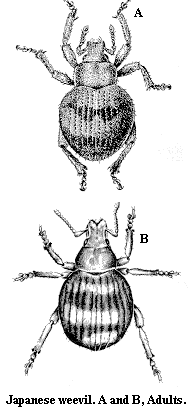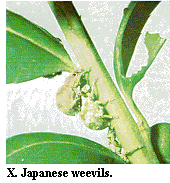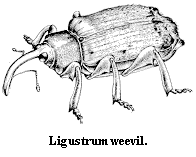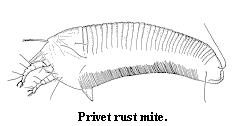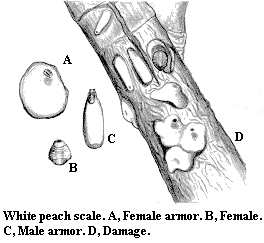Key to Ligustrum
Ligustrums are hardy plants ideally adapted to conditions in the Southeast. Generally fast growing, ligustrums, or privets, are available in a variety of leaf forms, shades of green, and growth habits. Southern nurserymen produce 660,000 ligustrums each year. As a rule, ligustrums require little care, although at least two weevils, white peach scale, and rust mites occasionally cause problems.
- Japanese weevil – Little, chunky, dark beetles with pale bands across the back chewing notches from leaf margins during the day; occasionally present in large numbers.
- Ligustrum weevil – Little, shiny brownish-yellow beetles that feed by chewing oblong holes in leaves late at night.
- Privet rust mite – Foliage dull, russeted, and cupped; microscopic mites are present in large numbers in the growing season.
- White peach scale – Round, dingy-white scales with yellow exuviae in the center (2 mm across) and slender, pure-white scales 2 mm long on bark, twigs, and sometimes leaves.
Japanese Weevil
Japanese weevil, Psendocneorhinus bifasciatus Roelofs, Curculionidae, COLEOPTERA
DESCRIPTION
Adult – The Japanese weevil varies in size from 4.5 to 7 mm. It is light or dark brown with a short, blunt snout. The wing covers (elytra) are striped with indistinct white lines in the grooves, white spots on the apical half, and a dark brown or black transverse band (Figure X).
Egg – The eggs are small and cream colored.
Pupa, Larva – The pupal and larval stages have not been described.
BIOLOGY
Distribution – This introduced pest was first found in the United States in 1914 near Philadelphia. The Japanese weevil is now firmly established in the eastern United States, where it feeds on a number of ornamental plants. It occurs in New England, the Middle Atlantic states, Kentucky, and Indiana.
Host Plants – Some of the plants attacked by the Japanese weevil are ash, azalea, barberry, burr marigold, camellia, dogwood, elm, fern, hemlock, holly, lilac, mountain laurel, privet, rhododendron, rose, spirea, strawberry, and weigela.
Damage – Japanese weevil larvae feed on plant roots, but the adults do more serious and apparent damage. The weevils feed extensively on new leaves, shoots, and inner foliage. As a result, infested plants are tattered and unhealthy in appearance.
Life History – It is assumed that the Japanese weevil is parthenogenetic because no males have been recorded. Eggs are deposited in folds along the margins of leaf fragments or dead leaves, and the free edge is sealed to form a pod. When the eggs hatch, the larvae burrow into the ground and feed on the roots. These weevils have fused elytra and thus are unable to fly. They feed during the day and, if disturbed, drop to the ground and remain motionless. There is only one generation each year.
CONTROL
For specific chemical controls, see the current state extension recommendations.
Ligustrum Weevil
Ligustrum weevil, Ochyronmera ligustri Warner, Curculionidae, COLEOPTERA
DESCRIPTION
Only the adult stage of the ligustrum weevil has been described.
Adult – An adult ligustrum weevil is shiny brown with golden-yellow setae. It has a definite median stripe and an obscure lateral stripe. The prothorax is wider than it is long and strongly rounded on the sides. The insect is about 3.9 mm long, and the rostrum or "bill" is about 1.0 mm long (but varies considerably).
BIOLOGY
Distribution – The ligustrum weevil was described in 1959 from specimens collected in Wake County, North Carolina. Because the genus of the ligustrum weevil, Ochyromera is generally found in eastern Asia, this weevil is probably an introduced species. It has now been found in North Carolina and South Carolina.
Host Plants – Ligustrum weevils favor Japanese privet but also feed on common privet, glossy privet, and lilac.
Damage – With their chewing mouthparts the ligustrum weevil adults form jagged holes in the leaves while they feed. They often destroy the buds, causing bunchy growth and a tattered appearance.
Life History – Adults emerge from ligustrum seeds beginning in late May and feed on the leaves and pollen. The adult ligustrum weevils are most common in May, June, and early July. Adults feed at night and prefer wilted foliage. About the first of July, eggs are laid in the seed capsules of fruit of privets. A small, slightly curved incision can be seen on the seed where the egg has been deposited. In a few weeks the eggs hatch, and the larvae feed in the fruit or seed capsules throughout the fall and winter. By late April, the larvae are fully developed and they pupate. There is only one generation each year.
CONTROL
Ligustrum weevils may be controlled by shearing off flowers and fruits of ligustrum. For specific chemical controls, see the current state extension recommendations.
Privet Rust Mite
Privet rust mite, Aculus ligustri (Keifer) Eriophyidae PROSTIGMATA
DESCRIPTION
Adult – Rust mites are generally broader than other eriophyid gall mites and are more sclerotized. Microscopic examination is usually required to see these minute mites. Unlike other mites, eriophyid adults have only four legs in the adult stage. Adult privet rust mites are slightly curved, spindle shaped with numerous microtubercles encircling the body, brown, and slightly less than 0.2 mm long.
Egg – The egg has not been described.
Nymph – The nymphal stages look similar to the adult.
BIOLOGY
Distribution – The privet rust mite has been reported from California and Georgia. These records suggest that it occurs throughout the Southeast.
Host Plants – Since eriophyid mites are usually very host specific, the privet rust mite is probably-restricted to privet.
Damage – Infestations of the privet rust mite will cause the leaf surface to appear scratched, the leaves to turn brown, and the young leaves to curl.
Life History – Privet rust mites become active shortly after the leaves begin to develop in the spring. In the spring and early summer, the mites multiply rapidly on the leaves and green stems; but by the end of June, no living mites can be found on the leaves. Hot weather decreases the Mite population, and it is not until the cooler fall weather that the mites revive and begin to multiply vigorously again. During the warm summer period, the mites survive as aestivating females under old bud scales at the base of the current season's growth.
The typical life cycle of eriophyid mites includes an egg, two nymphal instars, and an adult stage. Mites can develop from eggs to adults in only 1 week under favorable conditions. The mites can be distributed to other plants by wind, insects, and birds.
CONTROL
For specific chemical controls, see the current state extension recommendations.
White Peach Scale
White peach scale, Aculus ligustri (Keifer) Eriophyidae, PROSTIGMATA
DESCRIPTION
Adult – The female scale is 1 to 2.25 mm in diameter, circular, convex, and thickened. It is white, yellowish white, or grayish white with a yellow or reddish spot (the cast skin of the nymph). The male adult scale is a small, two-winged insect that looks like a gnat but has two tail filaments.
Egg – The female egg is coral colored, and the male egg is pinkish white. The tiny eggs are found beneath the female scale.
Nymph – The female nymphal scale looks like the adult but is smaller and lacks the spot on the scale. The male nymph is elongate oval, white or dirty white, and about 1 mm long. Crowding and particular host plants can affect the shape and color of the scale considerably.
BIOLOGY
Distribution – The white peach scale is found throughout the southern part of the United States and as far north as Connecticut.
Host Plants – As its name implies, the white peach scale is a pest of peach. However, this insect feeds on many other plants of economic and ornamental value. Some of the most frequently infested ornamentals are chinaberry, flowering peach, French mulberry, and persimmon; but other hosts include catalpa, lilac, privet, and walnut.
Damage – The white peach scale feeds on the bark, fruit, or leaves of the host plant. Its feeding can cause stunting, leaf drop, and death of entire branches.
Life History – Overwintering as adult females, white peach scales become active in the spring and begin depositing eggs about April 1 in the Southeast. The insects continue laying eggs for approximately 30 days. Female eggs are produced before male eggs during the sequence of egg-laying. In 3 or 4 days, the eggs hatch into young nymphs or crawlers. Female crawlers are more active than their male counterparts. The crawlers settle and begin feeding within 2 days. The first nymphal stadium lasts 7 or 8 days. The second female nymphal stadium lasts about 12 days. The adult emerges after the second molt. Second instar male nymphs molt about 5 days after their first molt and then emerge from their scales in 7 or 8 days as adults. The emergence of the male scale and the final molt of the female scale coincide. After molting, male scales die within 24 hours. Fourteen to 16 days after mating, the females begin to lay eggs. At 25°C, a generation is completed in 35 to 40 days. There are three generations per year in the Southeast. Because mortality of the first and second generations is high, the movement of the scale to other plants occurs mostly during the third generation in September and October.
CONTROL
Because the insect may be found on the undersurfaces of branches, it is important to treat all infested areas on the plant. For specific chemical controls, see the current state extension recommendations.
Publication date: Jan. 1, 1993
Reviewed/Revised: Aug. 9, 2024
AG-189
Other Publications in Insect and Related Pests of Shrubs
N.C. Cooperative Extension prohibits discrimination and harassment regardless of age, color, disability, family and marital status, gender identity, national origin, political beliefs, race, religion, sex (including pregnancy), sexual orientation and veteran status.

